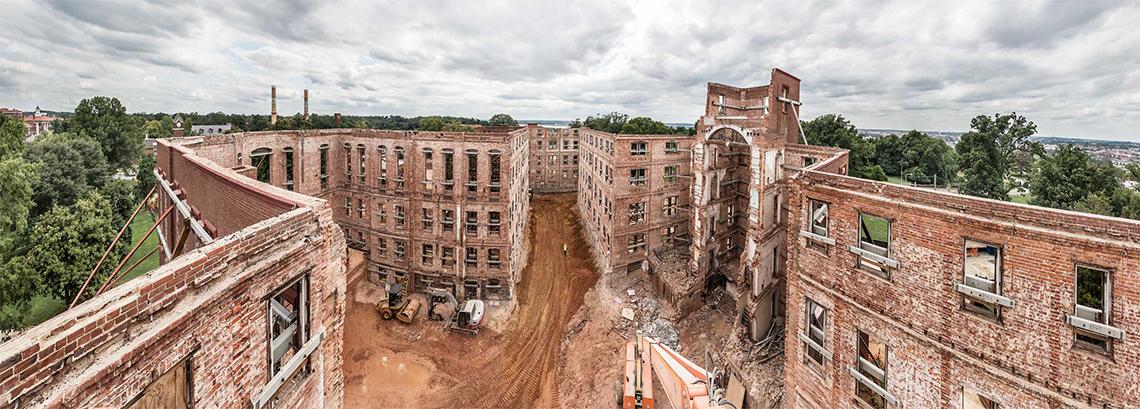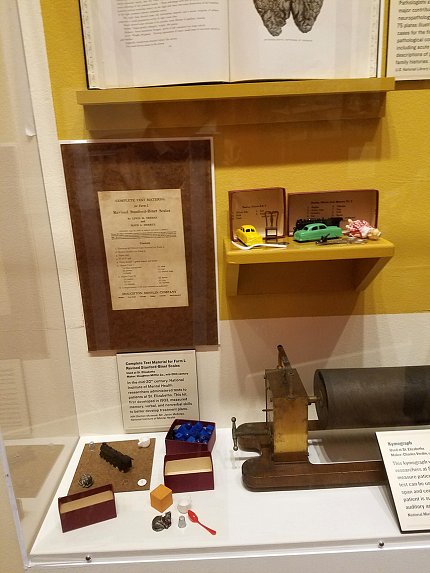‘Architecture of Asylum’
NIH Stetten Museum Loans Objects to Exhibit on St. Elizabeths

Photo: COLIN WINTERBOTTOM ©
Visit the National Building Museum for the exhibit “Architecture of an Asylum: St. Elizabeths, 1852-2017,” featuring objects loaned by NIH’s DeWitt Stetten Jr. Museum of Medical Research. The exhibit tells the story of the hospital for the mentally ill through the design, construction and development of its buildings and grounds.
St. Elizabeths (no apostrophe) opened as the Government Hospital for the Insane in 1852. Its design followed the Moral Treatment Plan for mental illness based on humane treatment and oversight and physical labor. Dr. Thomas Kirkbride (1809-1883) proposed the specifics of such a plan: only about 250 patients were to live in well-ventilated buildings set in bucolic scenery where they would provide farm labor to supply as much of the hospital’s needs as possible. The exhibit tells how St. Elizabeths was initially a model of Kirkbride’s plan and changed over the next 150 years as other approaches and technologies for mental health care came and went.
The exhibit incorporates architectural features from St. Elizabeths in its design, such as doorways and window frames, which add a sense of place. In addition to discussing the link between medical treatment and architecture, the exhibit also explores segregation, entertainment and recreation and the decline of the asylum era of treatment with photographs, models, maps and objects.
Two of those objects were loaned by the Stetten Museum. The first was a handbook for students at the live-in nursing school, which was open from 1894 to 1952. The handbook, dating from about 1950, presented in straightforward terms the rules by which the student nurses were to live at St. Elizabeths, covering how they should keep their rooms, hang their clothes and play their music.

Photo: Michelle Lyons
The second loaned object is a psychological test (shown above): the Complete Test Material for Form L Revised Stanford-Binet Scales. This is part of the Stetten Museum’s collection of scientific instruments and psychological tests used at St. Elizabeths by researchers in the National Institute of Mental Health. The collection was donated to the Stetten Museum by Jason McEntee of NIMH. This particular kit measured memory, verbal and nonverbal skills to better develop treatment plans.
NIMH has a long history at St. Elizabeths, running the federal government’s only civilian psychiatric hospital from 1967 to 1987, when administrative control was transferred to the District of Columbia. NIMH retained research facilities on the grounds of the hospital; the NIMH Neuroscience Center and the NIMH Neuropsychiatric Research Hospital were dedicated on Sept. 25, 1989. They moved to the Bethesda campus in 1999. Currently, St. Elizabeths’ grounds are becoming the headquarters site for the U.S. Coast Guard and Department of Homeland Security on the west side and a residential community with a sports and entertainment complex on the east side.
“Architecture of an Asylum: St. Elizabeths, 1852-2017” is connected by more than object loans to the Stetten Museum. Its curator, Dr. Sarah Leavitt, is a former historian with the Office of NIH History.
The National Building Museum is located at the Red Line’s Judiciary Square Metro stop and is convenient to the lively restaurant scene on 7th St. NW. The exhibit will be open until Jan. 15, 2018.
